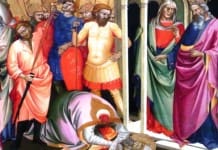At the young age of 17, Giovanni Battista Bugatti became the Official Executioner of the Papal States.
Bugatti was described as short and stout, always well dressed. Although married, he had no children. When he wasn’t carrying out his part-time duties, he and his wife were frequenters of the Santa Maria in Traspontina church and sold painted umbrellas and other souvenirs to tourists.
A respectable man, he called his executions justices and those condemned as patients.
As a resident of the Trastevere district of Rome, he was forbidden to leave his neighborhood unless on official business for fear of revenge sought by relatives of the executed.
When he did cross the bridge to leave however, the residents of Rome knew an execution was due to take place and word quickly spread as crowds gathered to witness the popular event.
From March 22nd, 1796 when he became Papal Executioner to 1810, the method of execution was beheading by axe, hanging, or even mallet. When the French instituted the guillotine, it was first used in the Papal States in 1816 until his last execution when he was retired by Pope Pius IX at the ripe age of 85.
The longest serving ever executioner in the Papal States, he was nicked Mastro Titta and was given a monthly pension of 30 Italian scudi, excellent compensation for the time.
His blood stained executioner’s clothes, axes, and guillotines remain on display today at the Criminology museum at the Oratory of the Banner building in Central Rome.


















[…] at Ignitum Today Exorcist Diary: Satan is Out to Destroy America – Msgr. Stephen Rossetti When the Vatican Had an Executioner – George Ryan at uCatholic Deconstructing the Deconstructors – Randall B. Smith, Ph.D., […]
I think it should be reinstituted and focused on the criminal element in the church, starting at the Cardinal level and working downward. Not a HUGE number of cases, but clearly far more corrupt to doctrine officials than should be tolerated. Yet, no action to correct. This may be a worthy alternative.
Now get the basic details for this game free roblox robux just click here.